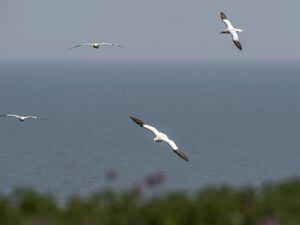UK seabirds devastated by bird flu in 2023 but whales and dolphins recover
The NGO’s roundup of the year for marine wildlife found some species that were traditionally hunted have been returning.

Bird flu has had a devastating impact on UK seabirds this year killing thousands of animals, according to The Wildlife Trusts’ annual roundup.
The last two years have seen the most severe outbreak in the UK since the virus emerged from a Chinese poultry farm in the 1990s.
Vast numbers have died, with the only nesting tern colony in Wales at Cemlyn Nature Reserve having halved since last year.
Hundreds of dead kittiwakes, herring gulls and guillemots washed up along the coast of Aberdeenshire this year while over 1,000 dead birds were removed from beaches in Pembrokeshire in July.
Dorset Wildlife Trust also found 600 mostly dead sandwich and common terns and black-headed gulls on Brownsea Island during the breeding season.
The Wildlife Trusts said there has been some cause for optimism in that northern gannets with black instead of pale blue eyes are more likely to be immune to the virus and that monitoring on Alderney near Guernsey suggests there has been no bird flu on the island this year.
The NGOs found other marine species to be recovering around the British Isles, notably the Atlantic bluefin tuna, which was fished almost to extinction in the 20th century.
It has been seen off the coasts of Devon and Cornwall as well as Scotland while dolphins and humpback whales have also been making comebacks.
There were multiple sightings of these animals in what are called bait ball feeding frenzies, when predators force fish into a tight ball near the surface to trap them and several species plunge in to feed at the same time.
Having so many sightings could be a sign that these populations are recovering after decades of being hunted by humans.

Dr Lissa Batey, head of marine conservation at The Wildlife Trusts, said: “Regulation is vital for protecting the natural world and reversing wildlife declines.
“The end of commercial whaling has brought humpbacks and fin whales back to UK waters, and measures to protect bluefin tuna has led to a spike in sightings.
“This fantastic fish has returned from the brink of extinction and the risk of decimating the population for a second time remains high, so it is vital that commercial fishing quotas are set realistically and rigorously enforced.
“When we give nature space, wildlife can recover, it’s as simple as that.
“We must act faster to protect the UK target of 30% of seas by 2030.”
Other threats also need to be resolved, such as that from pollution from sewage, plastic and industrial processes, The Wildlife Trusts said.

Thousands of small blue rubber balls used in an EDF power station were found washed up on beaches in Teesside and nurdles, tiny, raw forms of plastic that are fatal if eaten by wildlife – have washed up on UK beaches and are thought to have spilled from container ships.
This year also saw the introduction of highly protected marine areas (HPMAs) in Allonby Bay, Cumbria, Dolphin Head, Sussex and north-east of Farnes Deep in the North Sea.
Destructive practices such as trawling are banned in these areas and The Wildlife Trusts celebrated their introduction but said there needs to be a massive expansion if they are to have any serious impact as they cover just 0.4% of English seas.
Dr Batey said: “This new gold-standard of protection will stop all damaging activities such as trawling and enables marine wildlife to recover, benefiting fishers and carbon storing habitats.
“These special places cover less than half a percent of English seas, so it’s a tiny first step towards more designations.”





